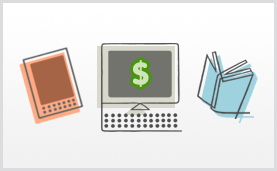
The online book market moves so fast that we frequently have to take a step back and reevaluate. In that spirit, I recently reflected on four key trends that we saw in both the eBook and physical book sales numbers for our online accounts last year.
Here are the Online Sales team’s biggest takeaways from last year:
1. Slower growth is growth nonetheless
Despite a few early reports of their demise, eBooks are alive and well. It’s probably unrealistic to assume eBook growth will continue at the torrid rate it has experienced for the past few years, and (based on our numbers) it is true that the overall growth rate of eBook sales has slowed considerably. But, eBook sales in 2012 were still well above what they were in 2011 and some accounts are still experiencing triple-digit growth. So is the growth slowing? Most likely, yes. Is the “eBook revolution” over? Not by a long shot.
2. The “70-20-10 Rule” is still in effect
While some recent phenomena have occasionally changed this ratio, for the most part our eBook sales by category can be explained by what I like to call the “70-20-10 Rule” (©2013 Jeff Weber, all rights reserved). Very simply, this means that despite increases in the number of devices and titles available, eBook sales remain roughly 70 percent adult fiction, 20 percent adult nonfiction, and 10 percent children’s & teen.

3. The “Load-Up Factor” may be gone
Early signs point to 2012 possibly being the last we’ll see of the “Load-Up Factor” (©2013 Jeff Weber, all rights reserved). What I mean by that is the enormous spike in sales we’ve traditionally seen on Christmas Day, when people receive eReaders as gifts. Most people then immediately start to build a library by buying several books at once. This Christmas, while we did see an increase in sales from the previous day, sales were significantly down from Christmas Day 2011. The main reason for this? I think it’s because a large number of eReading devices that were purchased (be they dedicated eReaders, tablets, or even phones) were actually replacement devices for those who have already developed an eBook library. Think back to when you got your first iPod—how many songs did you buy that day? When you then bought a new one, or an iPhone or iPad, did you buy the same number of songs? My guess is that many eBook customers have reached that point.
4. Physical books are just fine
EBook growth does not equate to a decline in sales of physical books through online accounts. In fact, this past holiday season Random House saw double-digit growth for physical books at our online accounts. This isn’t simply because titles that traditionally sell in physical format (art books, cookbooks, etc.) are top sellers over the holidays, but rather reflects that our bestselling eBook titles are often also our bestselling physical book titles. So, while we’ve recently tended to focus on the format, the content continues to be what really matters.
Jeff Weber is a Vice President in the Online & Digital Sales team.

